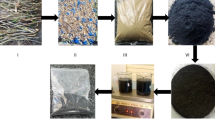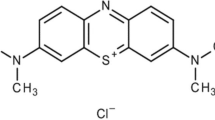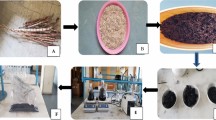Abstract
Many of the basic dyes are non- degradable and toxic pollutants in textile industrial wastewater. Methylene blue (MB) is a cationic dye that exists at a large scale in the textile wastewater which is discharged into the nearby environment without proper management, particularly in developing countries including Ethiopia. Therefore, this study aimed to evaluate the adsorption performance of MB from textile wastewater using locally prepared activated carbon produced from Parthenium hysterophorus stem. The plant samples were activated using H3PO4. The activated carbon was then characterized using proximate analysis, scanning electron microscope and Fourier transform infrared spectroscopy. Batch adsorption studies were conducted to determine the optimum condition for removal of MB from synthetic and real textile industrial wastewater under the effect of pH, contact time, adsorbent dose, and initial MB concentration. The adsorption isotherms were checked using Langmuir and Freundlich isotherms models. The result of the proximate analysis has shown that the activated carbon was composed of 5.7% moisture, 15.3% ash, 18.6% volatile matter and 60.4% fixed carbon. Using an aqueous solution, the maximum MB removal of 94% was achieved at the pH value 11, contact time 100 min, adsorbent dose 2 g in 100 mL and at the initial MB concentration 100 mg/L, whereas the maximum removal of MB from actual textile wastewater was found to be 91%. The Langmuir isotherm model was best fitted with experimental values at R2 was 0.99. Finally, it can be concluded that the activated carbon has a good adsorption capability and promising for MB removal from textile wastewater at an industrial scale.
Article Highlights
-
Wastewater pollution is the major concern of public and environmental health problem.
-
Water reclamation is the newly emerged approach to achieve sustainable development.
-
Methylene blue is a toxic and non-degradable chemical that discharged from the textile industry.
-
Adsorption is one of the promising treatment technology for Methylene blue remediation.
-
Activated carbon that produced from Parthenium hysterophorus is effective for Methylene blue removal from industrial wastewater.









Similar content being viewed by others
Availability of DATA and Materials
All data are fully available without restriction.
References
Adegoke KA, Solomon O (2015) Dye sequestration using agricultural wastes as adsorbents. Water Resour Ind 12:8–24. https://doi.org/10.1016/j.wri.2015.09.002
Ajmal M, Rao RAK, Ahmad R, Khan MA (2006) Adsorption studies on Parthenium hysterophorous weed: removal and recovery of Cd(II) from wastewater. J Hazard Mater 135:242–248. https://doi.org/10.1016/j.jhazmat.2005.11.054
Amalraj A, Pius A (2017) Removal of fluoride from drinking water using aluminum hydroxide coated activated carbon prepared from bark of Morinda tinctoria. Appl Water Sci 7:2653–2665. https://doi.org/10.1007/s13201-016-0479-z
Anisuzzaman SM, Joseph CG, Taufiq-Yap YH et al (2015) Modification of commercial activated carbon for the removal of 2,4-dichlorophenol from simulated wastewater. J King Saud Univ Sci 27:318–330. https://doi.org/10.1016/j.jksus.2015.01.002
Bapat SA, Jaspal DK (2016) Parthenium hysterophorus: novel adsorbent for the removal of heavy metals and dyes. Glob J Environ Sci Manag 2:135–144. https://doi.org/10.7508/gjesm.2016.02.004
Bedada D, Angassa K, Tiruneh A et al (2020) Chromium removal from tannery wastewater through activated carbon produced from Parthenium hysterophorus weed. Energy Ecol Environ 5:184–195. https://doi.org/10.1007/s40974-020-00160-8
Chatterjee S, Kumar A, Basu S, Dutta S (2012) Application of response surface methodology for methylene blue dye removal from aqueous solution using low cost adsorbent. Chem Eng J 181–182:289–299. https://doi.org/10.1016/j.cej.2011.11.081
Choong CE, Wong KT, Jang SB et al (2020) Fluoride removal by palm shell waste based powdered activated carbon vs. functionalized carbon with magnesium silicate: implications for their application in water treatment. Chemosphere 239:124765. https://doi.org/10.1016/j.chemosphere.2019.124765
De Gisi S, Lofrano G, Grassi M, Notarnicola M (2016) Characteristics and adsorption capacities of low-cost sorbents for wastewater treatment: a review. Sustain Technol 9:10–40. https://doi.org/10.1016/j.susmat.2016.06.002
Dehghani MH, Farhang M, Afsharnia M, Mckay G (2018) Adsorptive removal of fluoride from water by activated carbon derived from CaCl2-modified Crocus sativus leaves: equilibrium adsorption isotherms, optimization, and influence of anions. Chem Eng Commun. https://doi.org/10.1080/00986445.2018.1423969
Fito J, Said H, Feleke S, Worku A (2019) Fluoride removal from aqueous solution onto activated carbon of Catha edulis through the adsorption treatment technology. Environ Syst Res 8:1–10. https://doi.org/10.1186/s40068-019-0153-1
Goswami L, Vinoth Kumar R, Borah SN et al (2018) Membrane bioreactor and integrated membrane bioreactor systems for micropollutant removal from wastewater: a review. J Water Process Eng 26:314–328. https://doi.org/10.1016/j.jwpe.2018.10.024
Guillossou R, Le Roux J, Mailler R et al (2019) Organic micropollutants in a large wastewater treatment plant: what are the benefits of an advanced treatment by activated carbon adsorption in comparison to conventional treatment? Chemosphere 218:1050–1060. https://doi.org/10.1016/j.chemosphere.2018.11.182
Hegazy AK, Abdel-Ghani NT, El-Chaghaby GA (2014) Adsorption of phenol onto activated carbon from seaweed: determination of the optimal experimental parameters using factorial design. Appl Water Sci 4:273–281. https://doi.org/10.1016/j.jtice.2011.04.003
Hesas RH, Arami-Niya A, Wan Daud WMA, Sahu JN (2013) Preparation and characterization of activated carbon from apple waste by microwave-assisted phosphoric acid activation: application in methylene blue adsorption. BioResources 8:2950–2966
Hua Y, Xiao J, Zhang Q et al (2018) Facile synthesis of surface-functionalized magnetic nanocomposites for effectively selective adsorption of cationic dyes. Nanoscale Res Lett 13:99
Hunter RG, Day JW, Wiegman AR, Lane RR (2018) Municipal wastewater treatment costs with an emphasis on assimilation wetlands in the Louisiana coastal zone. Ecol Eng. https://doi.org/10.1016/j.ecoleng.2018.09.020
Islam MN, Khan MN, Mallik AK, Rahman MM (2019) Preparation of bio-inspired trimethoxysilyl group terminated poly(1-vinylimidazole)-modified-chitosan composite for adsorption of chromium (VI) ions. J Hazard Mater 379:120792. https://doi.org/10.1016/j.jhazmat.2019.120792
Lata H, Garg VK, Guptaa RK (2008a) Adsorptive removal of basic dye by chemically activated Parthenium biomass: equilibrium and kinetic modeling. Desalination 219:250–261. https://doi.org/10.1016/j.desal.2007.05.018
Lata H, Mor S, Garg VK, Gupta RK (2008b) Removal of a dye from simulated wastewater by adsorption using treated parthenium biomass. J Hazard Mater 153:213–220. https://doi.org/10.1016/j.jhazmat.2007.08.039
Ma J, Jia Y, Jing Y et al (2012) Kinetics and thermodynamics of methylene blue adsorption by cobalt-hectorite composite. Dye Pigment 93:1441–1446. https://doi.org/10.1016/j.dyepig.2011.08.010
Meski S, Ziani S, Khireddine H et al (2011) Factorial design analysis for sorption of zinc on hydroxyapatite. J Hazard Mater 186:1007–1017. https://doi.org/10.1016/j.jhazmat.2010.11.087
Nautiyal P, Subramanian KA, Dastidar MG (2016) Adsorptive removal of dye using biochar derived from residual algae after in situ transesterification: alternate use of waste of biodiesel industry. J Environ Manage 182:187–197. https://doi.org/10.1016/j.jenvman.2016.07.063
Nethaji S, Sivasamy A, Mandal AB (2013) Adsorption isotherms, kinetics and mechanism for the adsorption of cationic and anionic dyes onto carbonaceous particles prepared from Juglans regia shell biomass. Int J Environ Sci Technol 10:231–242. https://doi.org/10.1007/s13762-012-0112-0
Niazi L, Lashanizadegan A, Sharififard H (2018) Chestnut oak shells activated carbon: preparation, characterization and application for Cr(VI) removal from dilute aqueous solutions. J Clean Prod 185:554–561. https://doi.org/10.1016/j.jclepro.2018.03.026
Nure JF, Shibeshi NT, Asfaw SL et al (2017) COD and colour removal from molasses spent wash using activated carbon produced from bagasse fly ash of Matahara sugar factory, Oromiya region, Ethiopia. Water SA 43:470–479. https://doi.org/10.4314/wsa.v43i3.12
Nwabanne J, Igbokwe P (2012) Application of response surface methodology for preparation of activated carbon from palmyra palm nut. N Y Sci J 5:18–25
Ozturk E, Cinperi NC (2018) Water efficiency and wastewater reduction in an integrated woolen textile mill. J Clean Prod 201:686–696. https://doi.org/10.1016/j.jclepro.2018.08.021
Pongener C, Bhomick PC, Supong A et al (2018) Adsorption of fluoride onto activated carbon synthesized from Manihot esculenta biomass—equilibrium, kinetic and thermodynamic studies. J Environ Chem Eng 6:2382–2389. https://doi.org/10.1016/j.jece.2018.02.045
Rafatullah M, Sulaiman O, Hashim R, Ahmad A (2010) Adsorption of methylene blue on low-cost adsorbents: a review. J Hazard Mater 177:70–80. https://doi.org/10.1016/j.jhazmat.2009.12.047
Rizzo L, Malato S, Antakyali D et al (2019) Consolidated vs new advanced treatment methods for the removal of contaminants of emerging concern from urban wastewater. Sci Total Environ 655:986–1008. https://doi.org/10.1016/j.scitotenv.2018.11.265
Schier L, Lima D, Dennison M et al (2011) Adsorption modeling of Cr, Cd and Cu on activated carbon of different origins by using fractional factorial design. Chem Eng J 166:881–889. https://doi.org/10.1016/j.cej.2010.11.062
Sen SK, Patra P, Das CR et al (2019) Pilot-scale evaluation of bio-decolorization and biodegradation of reactive textile wastewater: an impact on its use in irrigation of wheat crop. Water Resour Ind 21:100106. https://doi.org/10.1016/j.wri.2019.100106
Sivarajasekar N, Baskar R (2014) Adsorption of basic red 9 on activated waste Gossypium hirsutum seeds: process modeling, analysis and optimization using statistical design. J Ind Eng Chem 20:2699–2709. https://doi.org/10.1016/j.jiec.2013.10.058
Suneetha M, Sundar BS, Ravindhranath K (2015) Removal of fluoride from polluted waters using active carbon derived from barks of Vitex negundo plant. J Anal Sci Technol 6:1–19. https://doi.org/10.1186/s40543-014-0042-1
Acknowledgements
We would like to thank Ethiopian Road Authority (ERA) and Addis Ababa Science and Technology University (AASTU) for the research fund and facilities which was done collaboratively for national capacity building.
Funding
This research work was supported by the Ethiopian Road Authority
Author information
Authors and Affiliations
Contributions
JF contributed to experimental design, the inception of the idea, experimental supervision, manuscript writing and editing, and revision, whereas SA and KA mainly contributed to manuscript editing and revision, and in addition, experiment work and data collection were carried out by SA.
Corresponding author
Ethics declarations
Conflict of interest
The authors declared that they have no conflict of interests.
Rights and permissions
About this article
Cite this article
Fito, J., Abrham, S. & Angassa, K. Adsorption of Methylene Blue from Textile Industrial Wastewater onto Activated Carbon of Parthenium hysterophorus. Int J Environ Res 14, 501–511 (2020). https://doi.org/10.1007/s41742-020-00273-2
Received:
Revised:
Accepted:
Published:
Issue Date:
DOI: https://doi.org/10.1007/s41742-020-00273-2




